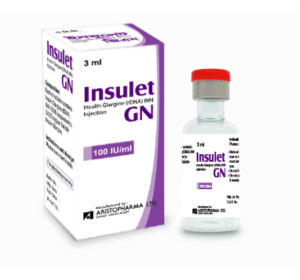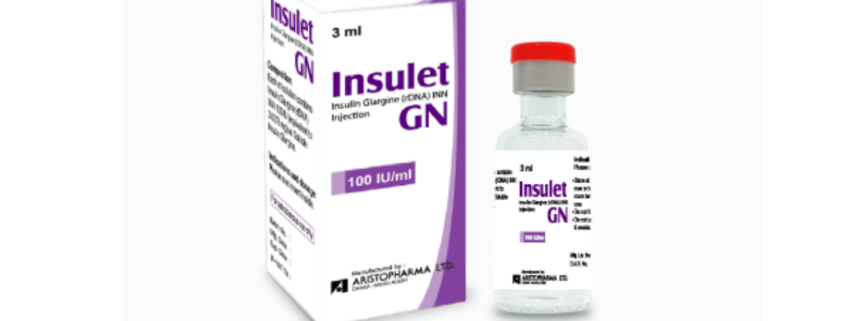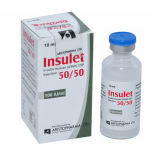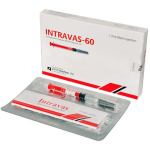Insulet GN (Insulin Glargine (rDNA))
Therapeutic Group : Antidiabetic

Presentation:
Insulet GN: Each ml solution contains Insulin Glargine (rDNA) INN 100 IU (equivalent to 3.6378 mg) as soluble Insulin Glargine.
Indications:
Insulet GN is indicated to improve glycemic control in adults and children with type 1 diabetes mellitus and in adults with type 2 diabetes mellitus.
Important limitations of use: Insulet GN is not recommended for the treatment of diabetic ketoacidosis. Intravenous short-acting insulin is the preferred treatment for this condition.
Dosage & Administration:
Insulet GN may be administered at any time during the day and should be administered subcutaneously once a day at the same time every day. The dose of Insulet GN must be individualized based on clinical response under the supervision of medical personnel. Blood glucose monitoring is essential in all patients receiving Insulet GN therapy. In patients with type 1 diabetes, Insulet GN must be used in regimens with short-acting insulin. The intended duration of activity of Insulet GN is dependent on injection into subcutaneous tissue. Intravenous administration of the usual subcutaneous dose could result in severe hypoglycemia. As with all insulins, injection sites should be rotated within the same region (abdomen, thigh, or deltoid) from one injection to the next to reduce the risk of lipodystrophy.
Initiation of Insulet GN therapy:
The recommended starting dose of Insulet GN in patients with type 1 diabetes should be approximately one-third of the total daily insulin requirements. Short-acting, premeal insulin should be used to satisfy the remainder of the daily insulin requirements. The recommended starting dose of Insulet GN in patients with type 2 diabetes who are not currently treated with insulin is 10 units (or 0.2 Units/kg) once daily, which should subsequently be adjusted to the patient’s needs. The dose of Insulet GN should be adjusted according to blood glucose measurement and should be individualized under the supervision of a healthcare provider in accordance with the needs of the patient.
Converting to Insulet GN from other insulin therapies:
If changing from a treatment regimen with intermediate- or long-acting insulin to a regimen with Insulet GN, the amount and timing of shorter-acting insulins and doses of any oral anti-diabetic drugs may need to be adjusted.
• If transferring patients from once-daily NPH Insulin to once-daily Insulet GN, the recommended initial Insulet GN dose is the same as the dose of NPH that is being discontinued.
• If transferring patients from twice-daily NPH insulin to once-daily Insulet GN, the recommended initial dose is 80% of the total NPH dose. This dose reduction will lower the likelihood of hypoglycemia.
• If transferring patients from twice daily premix insulin to once daily Insulet GN, the recommended initial dose is 80% of the intermediate acting portion of the premix insulin being discontionued.
Method of administration:
Insulet GN should only be administered subcutaneously once daily at the same time of the day. Injection is administered subcutaneously in the upper arm, thigh, buttock or abdominal wall and never to be administered intravenously. A subcutaneous injection into the abdominal wall results in a faster absorption than from other injection sites.
Preparation before use:
• Clean your hands.
• Shake or rotate the vial gently to mix the solution uniformly and check if the insulin glargine has the normal appearance.
• In case of using a new vial, flip off the plastic protective cap and wipe the rubber plug with an alcohol swab.
• Draw air into your syringe equal to the amount of insulin glargine needed. Puncture the needle into the vial and inject the air.
• Turn the bottle and syringe upside down and withdraw correct dose of insulin glargine into the syringe.
• Before pulling out the needle, check if there are any bubbles remain in the syringe. If so, put the syringe upright and tap the syringe to discharge the air bubbles.
Injection site:
•Choose the area where skin is less tight, such as the upper arm, thigh, buttock or abdomen.
•To avoid tissue damage, choose a site for each injection that is at least 1 cm from the previous injection site.
Injection method:
• Cleanse the skin with alcohol where the injection is to be made.
• Put the needle in such a position as to form 45° angle with the skin.
• Puncture the needle into skin and inject insulin glargine.
• Keep the needle under the skin for at least 6 seconds to make sure the entire dose is injected.
• Pull the needle out and apply gentle pressure over the injected site for several seconds.
• Do not rub the injection site.
Contrainidications:
Insulin glargine is contraindicated in patients with hypersensitivity to insulin glargine or any of its excipients.
Warning & Precautions:
1. Dose adjustment and monitoring: Monitor blood glucose in all patients. insulin glargine regimens should be modified cautiously and only under medical supervision.
2. Administration: Do not dilute or mix with any other insulin or solution. Do not administer subcutaneously via an Insuliln pump or intravenously because severe hypoglycemia can occur. Do not share reusable or disposable insulin glargine devices or needles between patients.
3. Hypoglycemia: Most common adverse reaction of insulin glargine therapy and may be life threatening.
4. Allergic reactions: Severe life threatening, generalized allergy, including anaphylaxis can occur.
5. Renal and hepatic impairment: May require a reduction in insulin glargine dose.
Side effects:
Hypoglycemia,hypersensitivity, allergic reactions etc.
Drug interaction:
A number of drugs affect glucose metabolism and may require insulin glargine dose adjustment and particularly close monitoring.
• The following drugs that may increase the blood-glucose-lowering effect of insulin glargine and, therefore, increase the susceptibility to hypoglycemia: oral anti-diabetic products, pramlintide, angiotensin converting enzyme (ACE) inhibitors, disopyramide, fibrates, fluoxetine, monoamine oxidase inhibitors, propoxyphene, pentoxifylline, salicylates, somatostatin analogs, and sulfonamide antibiotics.
• The following drugs may reduce the blood-glucose-lowering effect of insulin glargine: corticosteroids, niacin, danazol, diuretics, sympathomimetic agents (e.g., epinephrine, albuterol, terbutaline), glucagon, isoniazid, phenothiazine derivatives, somatropin, thyroid hormones, estrogens, progestogens (e.g., in oral contraceptives), protease inhibitors and atypical antipsychotic medications (e.g. olanzapine and clozapine).
• Beta-blockers, clonidine, lithium salts, and alcohol may either potentiate or weaken the blood-glucose-lowering effect of insulin glargine. Pentamidine may cause hypoglycemia, which may sometimes be followed by hyperglycemia.
• The signs of hypoglycemia may be reduced or absent in patients taking sympatholytic drugs such as beta-blockers, clonidine, guanethidine, and reserpine.
Use in special groups:
Use in pregnancy: Insulin glargine should be used during pregnancy only if the potential benefit justifies the potsntial risk of the fetus.
Use in lactation: It is unknown whether insulin glargine is excreted in human milk. Care should be taken when insulin glargine is administered to nursing mother.
Use in Renal/ Hepatic impairment: Reduction in the insulin glargine doses may be required in these cases.
Packing:
Insulet GN Injection: Each glass vial contains 3 ml insulin glargine (rDNA).



